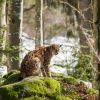The Rhön as a good example
Germany's best-known biosphere reserve is exemplary in many respects.

The Rhön is regarded worldwide as Germany's best-known UNESCO biosphere reserve. And because it is so exemplary – not only on a national level, but also internationally – we are presenting the Rhön here to represent all of Germany's 16 biosphere reserves.
The Rhön in facts and figures
Geographically, this biosphere reserve roughly covers the Rhön low mountain range and is spread over three German federal states: Bavaria, Hesse and Thuringia. Poetically, the region around the Wasserkuppe is also called the 'land of the open distances'. In contrast to other low mountain ranges, the peaks of the Rhön are largely unwooded and thus offer unique views and distant vistas.
Dieses YouTube-Video kann in einem neuen Tab abgespielt werden
YouTube öffnenThird party content
We use YouTube to embed content that may collect data about your activity. Please review the details and accept the service to see this content.
Open consent formUNESCO recognized the region as a biosphere reserve in 1991. It covers 2,433.2 square kilometres; the core zone, where any direct use of nature by agriculture or forestry is prohibited, comprises only 74.4 square kilometres.

What makes the Rhön special
Nature reserves are often defined by the presence of rare animals and plants. In the Rhön these are the red kite and the middle spotted woodpecker, the wildcat, the barbastelle bat and the Black Apollo butterfly. But also the Rhön's symbolic animal, an old farm animal breed called the Rhön sheep, is emblematic of the biosphere reserve's concept of producing products in an environmentally friendly way. Its nature-compatible innovations, sustainable hiking and cycling tourism and educational opportunities for sustainable development are what make the Rhön such an impressive and convincing place. The app 'Biosphärenreservat Rhön' (Rhön Biosphere Reserve) with tourist tips and information on a respectful approach to nature extends these opportunities into the digital world.
The example of Rhön sheep shows how regional value chains can function sustainably.
International networking
The Rhön attracts experts from all over the world who come here to learn about sustainable development. Furthermore, there are international partnerships with the South African biosphere reserve 'Kruger-to-Canyons Biosphere Region' and 'Oxapampa-Ashanika-Yanesha (BIOAY)' in Peru. Collaboration focuses on sustainability issues such as agriculture, value creation, education and population participation. In addition, international internships and stays abroad are organized.
Dieses YouTube-Video kann in einem neuen Tab abgespielt werden
YouTube öffnenThird party content
We use YouTube to embed content that may collect data about your activity. Please review the details and accept the service to see this content.
Open consent formYou would like to receive regular information about Germany? Subscribe here:




